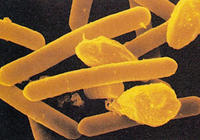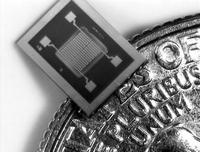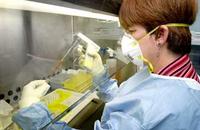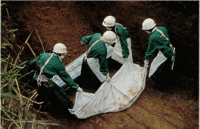-
Bioterrorism fears lead scientists to withhold information on new strain of botulism
The recent discovery of a new strain of botulism, the first in forty years, has alarmed California state health officials. The discovery was published in the Journal of Infectious Diseases in October 2013 — but the genetic sequence of the botulism toxin was removed from the report. The decision to withhold the sequencing information took into consideration the fact that there is currently no antitoxin capable of treating an outbreak of botulism, and that it takes about one to two years to develop an antitoxin. Should the classified information reach the wrong hands, a bioweapon, which can be spread as an aerosol, could be used to cause mass-casualty epidemic.
-
-
Preoccupation with bioterrorism hobbles preparations for natural spread of deadly viruses
Preoccupation with hypothetical bioterrorism attacks is leaving America more vulnerable to the threat of natural spread of deadly viruses. Since the 9/11 attacks, the federal government has poured billions of dollars to prevent and monitor threats of bioterrorism, yet the United States was ill-prepared for the swine flu outbreak of 2009. Experts say it is time to rebalance public health priorities so that preparations for the real threat of the outbreak of infectious diseases will not take a back seat to preparations for the more remote threat of bioterrorism.
-
-
Lying in wait: Anthrax toxin may lurk for days in cells as a lingering threat
An anthrax infection can be fatal even when the infectious agent is no longer detected. The bacterium responsible for anthrax develops a strategy reminiscent of the Trojan horse tale. Its pathogenic factor is able to penetrate inside a cell in such a way that it becomes completely invisible to both the immune system and medical analysis. Furthermore, it manages to exit the cell several days later, and then it continues to poison other cells.
-
-
Discovery points way to treatment of lethal toxin botulism

Botulinum neurotoxins are produced by Clostridium botulinum and cause the possibly fatal disease botulism, which impedes nerve cells’ ability to communicate with muscles and can lead to paralysis and respiratory failure. The botulinum toxin has also been identified as a potential biological weapon against a civilian population. Scientists have decoded a key molecular gateway for the toxin that causes botulism, pointing the way to treatments that can keep the food-borne poison out of the bloodstream.
-
-
New detectors for chemical, biological threats

In the late 1990s, Sandia scientists developed a simple-to-use handheld chemical detector for the military, the MicroChemLab. Ever since, Sandia has improved such microfluidics- and microelectromechanical (MEMS) systems-based instruments that identify chemicals based on gas chromatography, or GC, and resonator-style instruments such as surface acoustic wave (SAW) detectors. The lab’s researchers are building on this sensor work to invent tiny detectors that can sniff out everything from explosives and biotoxins to smuggled humans.
-
-
Worries grow about Syria’s biological weapons capabilities, intentions
The debates among experts in Western and Middle Eastern intelligence services and militaries about the use of chemical weapons by the Assad regime revolve around how many times Assad has used chemical weapons, not whether such weapons were used. Neighbors of Syria have become increasingly alarmed – and, in private, have expressed their anxiety in discussions with the United States – about another illicit Syrian WMD program: biological weapons. The readiness of the Assad regime to use one proscribed weapon – chemicals — has led to growing unease among Syria’s neighbors that the regime may not find it too difficult to violate other weapon-related taboos. Biological weapons could give the Assad regime an effective means of retaliation because, if the weapon is well-designed, the lethal contents would spread easily without leaving tell-tale signs about the origin of the attack – or even evidence that there has been an attack.
-
-
New understanding of key step in anthrax infection
Scientists advance A new hypothesis concerning a crucial step in the anthrax infection process. The research teams have explored the behavior of the toxins that rapidly overwhelm the body as the often-fatal disease progresses. Their findings suggest a new possible mechanism by which anthrax bacteria deliver the protein molecules that poison victims. Anthrax is easily weaponized; the findings could help lead to a more effective cure.
-
-
Lawmakers, scientists question FBI’s investigation, conclusion in 2001 anthrax attacks

Twelve years after the fall 2001 anthrax attacks, and six years after the 2007 FBI’s determination that Bruce Ivins, a top government anthrax researcher at the U.S. Army Medical Research Institute of Infectious Diseases (USAMRIID), was the perpetrator of the attacks (Ivins died in 2008 of apparent suicide), lawmakers and USAMRIID scientists insist that the FBI’s conclusions are not supported by scientific evidence – indeed, that some basic scientific facts make the Bureau’s conclusions untenable.
-
-
Scientists develop safe method for research on deadly flu viruses

In 2012, scientists around the world agreed to a worldwide, yearlong voluntary moratorium on research into the deadly H5N1 bird flu. The ban came after several scientific teams successfully altered the H5N1 viral genome to enable airborne transmission of the bird flu between ferrets — mammals considered a good research model for humans. The public health concern was that altered H5N1 could escape the lab, infect and spread among humans, producing a global pandemic. There was also concern that terrorists would use the altered H5N1 viral genome in large-scale bioterror attacks. Researchers have now been able to turn molecules in human lung cells into viral scissors that cut H5N1 bird flu and similar bugs into pieces. This dismantling of the viral genome in human lung cells will ensure safe research on deadly strains of influenza.
-
-
North Carolina’s biothreat warning system receives funding
The North Carolina Bio-Preparedness Collaborative (NCB-Prepared), a project to develop an early warning system to detect biothreats, has received $3 million in funding. The goal of NCB-Prepared project is to develop a statewide system that can detect and alert health officials and first responders within hours of an outbreak indicating a bioterror attack, contagious disease or illness, food-borne illness, and other biothreats.
-
-
U.S., South Korea teaming up for bioterrorism exercise
Officials from the United States and South Korea were in Seoul, South Korea last month for the third annual joint anti-bioterrorism exercise in Seoul. Around eighty U.S. officials and between 120 and 130 South Korean military officials participated in the tabletop exercise.
-
-
Antibiotic from a marine microorganism is effective against anthrax
A new potential drug from a marine microorganism is effective against anthrax. Researchers have isolated a species of Streptomyces from near-shore sediments near Santa Barbara, California. The culture extracts demonstrate significant activity against anthrax.
-
-
FDA-approved medications may stop deadly ebola

Ebola infections carry fatality rates of up to 90 percent. It strikes both humans and other primates, and there are fears it could be used as a biological weapon. There is no cure. New research suggests that a class of drugs that includes treatments for breast cancer and infertility appears able to inhibit the deadly, incurable Ebola virus.
-
-
DHS wants to upgrade BioWatch, but admits the system addresses a receding threat
The BioWatch program has cost more than $1 billion so far, and DHS wants billions more for upgrading it. The system is designed to detect large-scale bioterror attacks, but DHS, in its revised assessment of bioterror threats to the United States, said that rather than a massive release of germs in an American city – the kind of attack BioWatch sensors were aimed to detect – the more likely bioterror attacks are small-scale releases of anthrax or other pathogens. Such small-scale attack would likely not be picked up by BioWatch. Lawmakers want to know whether investing billions more in the system is worthwhile.
-
-
Fast, reliable identification of pathogens
Life-threatening bacterial infections cause tens of thousands of deaths every year in North America, but current methods of culturing bacteria in the lab can take days to report the specific source of the infection, and even longer to pinpoint the right antibiotic that will clear the infection. Researchers have created an electronic chip that can analyze blood and other clinical samples for infectious bacteria with record-breaking speed.
-
- All
- Regional
- Water
- Biometrics
- Borders/Immig
- Business
- Cybersecurity
- Detection
- Disasters
- Government
- Infrastructure
- International
- Public health
- Public Safety
- Communication interoperabillity
- Emergency services
- Emergency medical services
- Fire
- First response
- IEDs
- Law Enforcement
- Law Enforcement Technology
- Military technology
- Nonlethal weapons
- Nuclear weapons
- Personal protection equipment
- Police
- Notification /alert systems
- Situational awareness
- Weapons systems
- Sci-Tech
- Sector Reports
- Surveillance
- Transportation
Advertising & Marketing: advertise@newswirepubs.com
Editorial: editor@newswirepubs.com
General: info@newswirepubs.com
2010-2011 © News Wire Publications, LLC News Wire Publications, LLC
220 Old Country Road | Suite 200 | Mineola | New York | 11501
Permissions and Policies
Editorial: editor@newswirepubs.com
General: info@newswirepubs.com
2010-2011 © News Wire Publications, LLC News Wire Publications, LLC
220 Old Country Road | Suite 200 | Mineola | New York | 11501
Permissions and Policies
